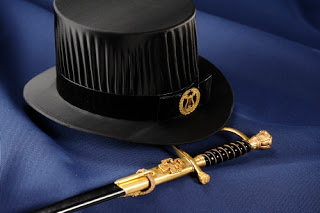PhD Defenses around the world: a defense in Finland
 Today, I am inviting Alexandra Mikhailova to discuss her PhD defense in the “Defenses around the world” series. Alex is turning 28 in less than two weeks, and is originally from Moscow, Russia. Her family relocated to Finland when she was 11, and she has lived in Tampere ever since. She got her MSc degree there as well, at the University of Tampere. She studied biomedical science and was especially interested in regenerative medicine, so she started working with pluripotent stem cells as an undergraduate student and continued in the same research group for her PhD. Right now, she is recovering from the defense and figuring out what to do next. Her plans are not set in stone yet though, so she can’t say anything for sure, but she will hopefully continue in the field of biomedicine and would like to engage more in scientific communication. In her free time she keeps herself busy by long-distance running and baking.
Today, I am inviting Alexandra Mikhailova to discuss her PhD defense in the “Defenses around the world” series. Alex is turning 28 in less than two weeks, and is originally from Moscow, Russia. Her family relocated to Finland when she was 11, and she has lived in Tampere ever since. She got her MSc degree there as well, at the University of Tampere. She studied biomedical science and was especially interested in regenerative medicine, so she started working with pluripotent stem cells as an undergraduate student and continued in the same research group for her PhD. Right now, she is recovering from the defense and figuring out what to do next. Her plans are not set in stone yet though, so she can’t say anything for sure, but she will hopefully continue in the field of biomedicine and would like to engage more in scientific communication. In her free time she keeps herself busy by long-distance running and baking.
I recently successfully defended my PhD in biomedical science at University of Tampere, Finland. The topic of my dissertation was “Tissue engineering for ocular surface reconstruction”. In a nutshell, the main aim of my study was to investigate differentiation of human pluripotent stem cells towards corneal epithelium.
First off, some background about writing a doctoral dissertation in Finland. In the field of life science and other “hard sciences”, doctoral dissertations are almost exclusively based on scientific publications. Typically three or four publications are needed for a PhD (this varies among universities), and the PhD student should have had a significant contribution to all of them. The actual PhD thesis should tie the publications together by introducing the general background of the study, summing up the results and discussing the main outcomes and limitations of the research. Once it is written and approved by the institute, two external reviewers evaluate the thesis and give feedback to the student to improve its quality. At this point, the reviewers can also reject the thesis if they feel it is not strong enough for a public defense. If that is the case, the PhD student has to make corrections to the thesis and go through the review process again. Once both external reviewers approve the thesis, the PhD student gets a permission to defend the dissertation.
The PhD defense is public from start to finish, and usually friends and family are invited in addition to colleagues and collaborators. There are also many formalities involved, most of which are somewhat old-fashioned. The dress code is strict and there are set phrases that have to be said at the beginning and at the end. The disputant, opponent and custos (a professor at the institute and preferably but not necessarily the supervisor) enter the auditorium at exactly 12:15, and the audience stands while they walk to the front of the room. The custos begins the defense by briefly introducing the disputant and opponent.
Then the disputant gives an introductory lecture (officially called Lectio praecursoria), for the public to get a general overview of the study background and aims. This tends to be the part where most disputants are noticeably nervous – my legs were feeling a little shaky for the entire 15 minutes of talking. Then the opponent gives a few general remarks which he/she thinks may be relevant. Usually this part is very short, maybe 5 minutes. However, at my defense, the opponent gave a fairly long presentation, to make sure the audience understood the aims of my study. After that, the actual discussion of the doctoral dissertation begins, and it takes 1-2 hours.
I’ve been to several PhD defenses before my own, and this part is very different every time, so you never really know what to expect. Some opponents ask very specific questions, while others choose to be broader. My opponent basically asked me to explain each of my three publications, and asked various questions related to them all throughout. Overall, I think I answered fairly well, although of course some questions were more difficult than others. It is somewhat common for the opponents to ask what are the main strengths and weaknesses of the PhD study, so I think it’s good to prepare an answer just in case. My opponent didn’t ask anything like that (although I had an answer ready!), but he did ask how I would choose to proceed in the project if money wasn’t an issue. Also a vague question, but I personally prefer those to the more technical ones, because it gives more room for discussion.
Finally, once the opponent is finished with the questions, he/she stands up to give a brief statement about the overall quality of the dissertation and defense. The disputant then thanks the opponent for the discussion and asks the audience if anyone has additional questions or comments. This is more of a formality, as it is very rare that someone from the audience asks anything.
The custos then announces that the defense is finished, and everyone is free to leave the auditorium after the disputant and opponent exit. Coffee and cake is served immediately after, and there is usually a party later in the evening in honor of the opponent. If they want to, PhD recipients in Finland can get a doctoral hat (looks somewhat like a top hat) and a doctoral sword for future academic occasions. But that’s basically all there is to it – several years of work and then one day it’s over and new challenges await!

